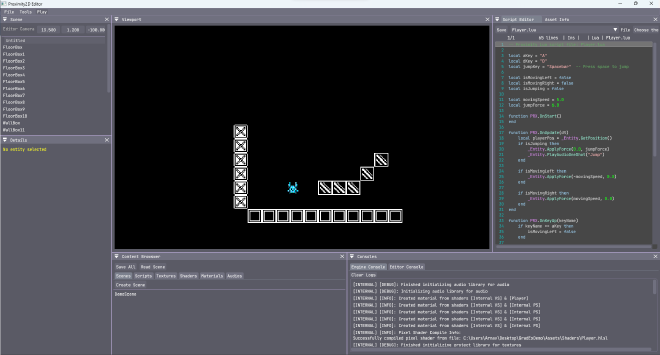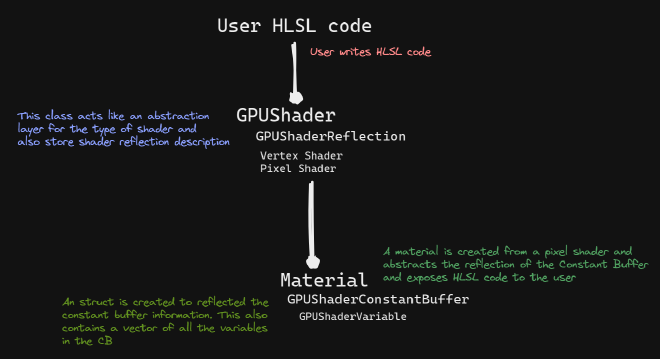Proximity Game Engine

Table of Contents
For my final year project for my university I made a simple 2D game engine. For this project I research what goes into making a game engine and try to implement my learnings. Written in C++ 20, DirectX 11 and HLSL and based on and ECS and event-driven architecture. The editor is also written in C++ using ImGui. It also supports entity scripting using Lua.
Watch the demo video here
Architecture #
The project consists of two sub projects - The Engine and the The Editor. The engine compiles to a static library (.lib) and the editor compiles to an executable (.exe)

Proximity’s architecture is inspired from Hazel and the initialization chain is inspired from Unreal Engine.

Engine Features #
Watch the demo videoHere are the key features of the engine, some of which are explained in detail after:
- Window and Input Handling
- Audio Engine using XAudio2
- Custom math library
- Event driven architecture using Actions
- Graphics engine and rendering using DirectX 11
- Filesystem and directory management
- Engine logging system
- Engine utilities
- Asset libraries (Audio, Shaders, Material, Textures, Scripts)
- Memory managers (Stack and Pool Allocators)
- Detailed HLSL shader reflection
- Scripting using Lua
- Physics using Box2D
- Game/Project Serialization using Yaml-Cpp
- Multiple scenes and project management
- Entity Component System using ENTT

HLSL Shader Reflection #
One of the most impressive features of the game engine is the shader reflection system. The user can write any HLSL code (vertex or pixel shader). The shader is then compiled and reflected within in the engine. The user can then create a Material which is a pair of vertex and pixel shaders. This material is then reflected in the editor; constant buffers and input resource slots can be manually edited from within the editor

Actions #
I recreated the System.Action<> class from C# in C++ 20. And this is what drives the communicatation between the engine and the editor and between the different editor panels.
The user can create custom action events (which may or may not take arguments) and bind their own functions/lamdas to these actions. Whenever an action is called, all the bound functions to this action are also called.
Lua Scripting #
The engine supports entity scripting using Lua and the Sol2 library. The engine creates a custom runtime environment for each script in the game. The user can call functions to and from C++ and Lua and all of this is made easy using the Sol2 library. The scripts are written in the built in script editor which also has support for syntax hightlighting for engine specific functions.
Conclusion #
During this project, I learnt so many new things about C++, HLSL, DirectX 11 as a whole. I believe I have built this project to be the showcase of my skills a C++ and engine programmer and is definitely will be the highlight project of my portfolio along with being the most complex project I’ve worked on till date. With some changes to the project and scope, I will definitely make Proximity 2.0, which will be faster with even more supported features.
I did not talk about the intricate details about all the features of this project or this would turn into a 30 minute long article. But you can always check out the project repository on github or contact me :)